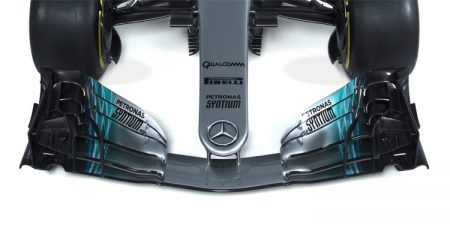
Dr. Bruno Lindl, Managing Director of Research and Development at the ebm-papst Group
“Due to the new rules for the 2017 season, at first glance the W08 EQ Power+ looks like it has changed dramatically: lower, broader and more aggressive looking. The bargeboards in front of the side pods, the sweptback front wing and lower rear wing with the lean auxiliary fin all stand out.
To assess these features from an aerodynamics viewpoint, of course you have to consider the general function of aerodynamic design. But you also have to be aware of the extent to which you can judge them from the outside – without looking at the results of simulations and measurements.
The basic principle of aerodynamics

The sweptback front wing creates higher tolerance for the turbulence. (Photo | Mercedes-Benz Grand Prix Ltd.)
Like with every other racecar the W08 EQ Power+ was designed to reduce the vehicle’s drag to a minimum, optimize the motor output for the track and ensure as much traction as possible. At high speeds, the vehicle’s weight alone is not enough. This is why Formula One® teams use components from fluid mechanics to prevent the drive wheels from spinning or maintain the lateral forces when the driver is steering. These components minimize the impact of turbulence from the car’s own front wheels or the vehicles in front.
Three key vehicle areas
The W08 EQ Power+ is lower and so its center of gravity is similarly lowered. This significantly improves traction, especially at high-speed corners. However, the car’s geometric design can only be understood when taken as a whole: the vehicle is purposefully designed. The shape of the nose and the front wing has much of a direct effect on the airflow around the rest of the W08 EQ Power+ as the tyres and chassis do.

The lower rear wing with the lean auxiliary fin (Photo | Mercedes-Benz Grand Prix Ltd.)
In general, the main task of the front wing is to create higher tolerance for the turbulence generated by the car itself or other cars. The front wing prevents air currents from getting underneath the vehicle and lifting it – especially in corners. Since the car’s weight is not much of a factor here, aerodynamic solutions are especially important. The rear wing on the contrary ensures the greatest contact force possible on the rear axle so the horsepower is optimally transmitted to the track. It supports the weight of the motor.
Last season, the space in front of the side pods had to remain empty. Now the W08 EQ Power+ has a multi-level bargeboard containing several air baffles. These fluid mechanics components do a great job at preventing turbulence from getting underneath the vehicle, giving it even more stability.
Season with many advanced developments

The multi-level bargeboard containing several air baffles (Photo | Mercedes-Benz Grand Prix Ltd.)
Formula OneTM never stands still and Mercedes-AMG Petronas Motorsport emphasizes that the advanced developments in the course of the season will play a more important role in the outcome of the World Championship than they did in previous years. This is because of the regulation changes and that teams will not be certain if their development and simulations are based on reality until the car performs on the track. However, this season one factor is making things more difficult: since the new rules permit greater freedom, it is not easy to predict what the turbulence in front of the vehicle will look like. The shape of a car determines the wake of turbulent air that each vehicle leaves behind. And the shape of the W08 EQ Power+ must be adapted to the others’ wakes.
As an experienced pilot, I know that three minutes should elapse between airplane landings since the turbulence generated during landing acts as an obstacle to the following plane and can even become dangerous. Formula OneTM cars have to master similar situations.”

Leave a comment